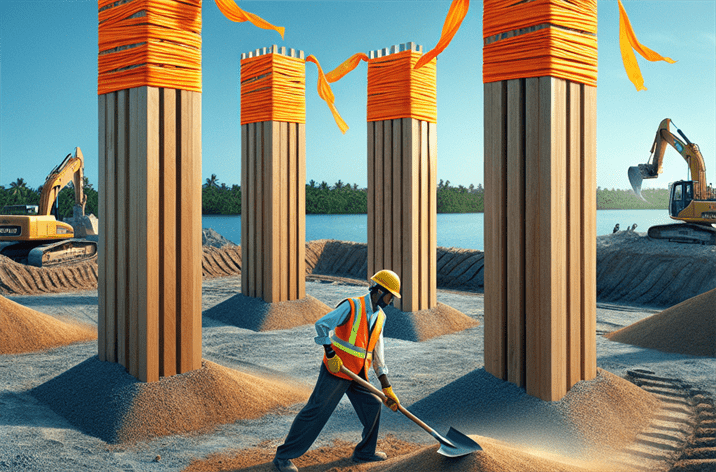A Comprehensive Guide to Types of Stakes in Construction
Introduction
When you think about the foundation of a construction project, you might envision heavy machinery or steel beams. However, one of the unsung heroes of construction is something much simpler: stakes. The types of stakes in construction play a crucial role in defining boundaries, guiding layouts, and ensuring precision on job sites. Did you know that the proper use of stakes can significantly enhance the efficiency and accuracy of your construction projects?
In this article, we’ll explore the different types of stakes used in construction, delve into their historical context, discuss their importance, and provide a detailed guide on how they work. Whether you are a seasoned contractor or a DIY enthusiast, understanding the nuances of construction stakes can elevate your projects and ensure that everything is perfectly aligned. By the end of this article, you will have a comprehensive understanding of the best stakes for construction and how to use them effectively.
What are the Types of Stakes in Construction?
Definition
Types of stakes in construction are pointed tools, usually made of wood or metal, that are driven into the ground to mark specific points, boundaries, or lines during construction projects. They serve multiple purposes, from indicating property lines to outlining the layout of a building or landscape.
Historical Context
Historically, stakes have been used for centuries in various forms of construction and land surveying. In ancient times, builders used rudimentary wooden stakes for construction to mark the corners of structures, while surveyors employed more advanced techniques involving measuring ropes and wooden markers to define land boundaries. Over time, as construction techniques evolved, so did the materials and methods used for stakes. Today, modern construction stakes are often made from durable materials such as treated wood, plastic, or metal, and they come in various sizes and shapes to accommodate specific project needs.
Importance of Types of Stakes in Construction
The significance of types of stakes in construction has only increased with the growth of the construction industry. As projects become more complex and precision becomes paramount, the role of stakes in maintaining accuracy cannot be overstated. They help avoid costly mistakes, ensure compliance with zoning laws, and provide a clear communication tool for all team members involved in a project.
For instance, in the residential construction sector, boundary stakes are crucial for ensuring that structures are built within property lines, preventing disputes with neighbors. On the other hand, in commercial projects, layout stakes help project managers visualize the structure’s footprint and coordinate with subcontractors effectively.
Key Players or Contributors
Notable players in the stakes and lath industry include manufacturers of construction materials and tools, such as Stans Industrial Manufacturing, which specializes in producing high-quality wooden stakes and lath for various construction needs. They have contributed significantly to the evolution of stakes by offering customizable and durable options that cater to the diverse requirements of modern construction projects.

How Do Types of Stakes in Construction Work?
The Mechanics of Types of Stakes in Construction
The process of using types of stakes in construction typically involves several steps. First, surveyors or construction managers will determine the layout of the project using blueprints or design plans. Next, they will place stakes at key points to outline the structure’s dimensions and boundaries. This step may involve using string lines or laser levels to ensure that the stakes are positioned accurately.
- Planning: Review the project plans and identify critical points that need to be marked.
- Placement: Drive the stakes into the ground at the designated points, ensuring they are stable and visible.
- Marking: Use string or chalk lines to connect the stakes, providing a clear visual reference for construction workers.
- Verification: Regularly check the alignment and positioning of the stakes to ensure accuracy throughout the project.
Technological Foundations of Types of Stakes in Construction
With advancements in technology, the methods of utilizing stakes have also evolved. Modern construction often incorporates tools like GPS and laser surveying systems that enhance the accuracy of stake placement. These technologies allow construction teams to achieve precise measurements and alignments, which are crucial for the structural integrity of buildings.
Real-World Applications of Types of Stakes in Construction
Types of stakes in construction are applied in various scenarios. For example:
- Boundary Stakes: Used to define property lines and ensure compliance with local zoning regulations. To learn more about this, check out our guide on boundary stakes and their role in defining property lines.
- Layout Stakes: Essential for marking out the layout of buildings or other structures. This helps prevent mistakes during the initial phases of construction.
- Grade Stakes: These help indicate the desired elevation of the ground before pouring concrete or laying foundations. For further insights, explore our article on grade stakes simplified.
Case Studies/Examples of Types of Stakes in Construction in Action
One notable example is the use of staking in large-scale civil engineering projects. For instance, during the construction of highways, survey stakes are used extensively to ensure that the road aligns perfectly with the planned route. This not only enhances safety but also improves the longevity of the structure.
Benefits and Drawbacks of Types of Stakes in Construction
Benefits:
- Accuracy: Stakes provide precise locations for construction layouts.
- Cost-effective: Using stakes for marking is generally less expensive than other methods.
- Ease of Use: They can be easily installed and adjusted as needed.
Drawbacks:
- Environmental Factors: Weather conditions can affect the stability of stakes, especially wooden ones.
- Visibility Issues: Stakes can be hard to see in busy construction sites, leading to potential errors.
The Benefits of Types of Stakes in Construction
Why Use Types of Stakes in Construction?
Understanding the benefits of types of stakes in construction can help you appreciate their value in any project. Here are some key advantages:
- Improved Efficiency and Productivity: Utilizing stakes can streamline the construction process by providing clear markers for workers to follow. This reduces the time spent on determining layouts and boundaries, allowing teams to focus on the actual building process.
- Enhanced Communication: Stakes serve as a visual aid that communicates important information to all team members. This clarity helps prevent misunderstandings about project boundaries and layout, ensuring everyone is on the same page.
- Cost-Effectiveness: Compared to other methods of marking and layout, stakes are relatively inexpensive. They provide a practical solution for defining areas without requiring extensive tools or technology. For affordable options, consider our guide on affordable wooden stakes for construction use.
- Versatility: Construction stakes come in various shapes and sizes, making them suitable for multiple applications, from small residential projects to large commercial endeavors.
- Durability: Modern stakes, especially those made from treated wood or durable plastic, are designed to withstand harsh weather conditions and repeated use on construction sites. For more on the longevity of construction stakes, explore our article on long-lasting wooden stakes for construction marking.
Challenges of Using Types of Stakes in Construction
While the benefits are significant, it’s essential to acknowledge some challenges that come with using types of stakes in construction:
- Environmental Impact: Wooden stakes can contribute to deforestation if sourced unsustainably. It’s vital to choose eco-friendly options to minimize environmental harm.
- Visibility Concerns: In busy construction sites, stakes can be overlooked, leading to errors in layout. To combat this, using brightly colored stakes or adding flagging can increase visibility.
- Wear and Tear: Over time, stakes can become damaged due to exposure to the elements, which can compromise their effectiveness. Regular inspections and replacements are necessary to maintain accuracy.
Future Trends in Types of Stakes in Construction
The construction industry is continually evolving, and so are the tools used within it. Here are some emerging trends regarding types of stakes in construction:
- Smart Stakes: As technology advances, we may see the introduction of smart stakes equipped with sensors that provide real-time data on positioning and alignment. These could revolutionize how construction projects are managed.
- Sustainable Materials: There is a growing emphasis on eco-friendly materials in construction. Expect to see more stakes made from sustainable resources, reducing the environmental impact of construction activities.
- Integration with Drones: The combination of drones and stakes could enhance surveying processes, allowing for precise aerial mapping and layout verification.
Conclusion
In conclusion, understanding the types of stakes in construction is vital for anyone involved in building projects. They serve not only as markers but also as essential tools for ensuring accuracy, communication, and efficiency on-site.
As we’ve explored, the benefits far outweigh the challenges, especially when proper practices are followed. Whether you’re marking boundaries, laying out foundations, or ensuring compliance with local regulations, using the right stakes can make all the difference.
Now that you have a comprehensive view of stakes in construction, take action! Evaluate your current practices and consider how implementing proper staking techniques can enhance your next project. Explore our resources on the essential role of surveying stakes in construction projects.
Resource Links:
1. ConstructConnect – Overview of different types of stakes used in construction projects, including their purposes and applications.
2. The Balance SMB – Detailed explanation of various types of stakes, their uses, and how they affect construction planning.
3. Engineering Toolbox – A resource detailing the types of stakes commonly used in engineering and construction, along with their specifications.

